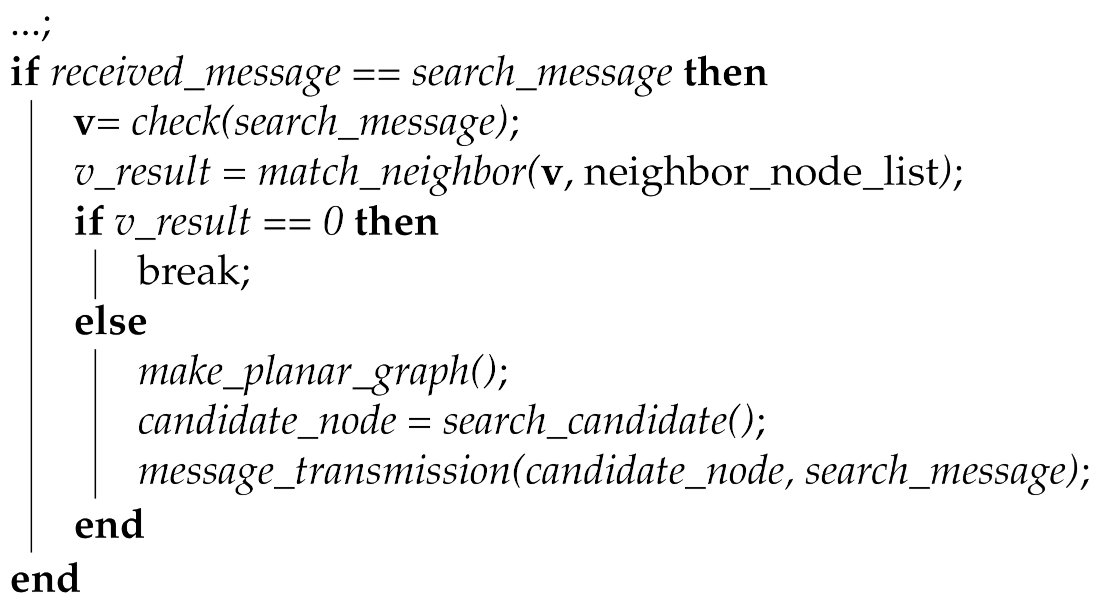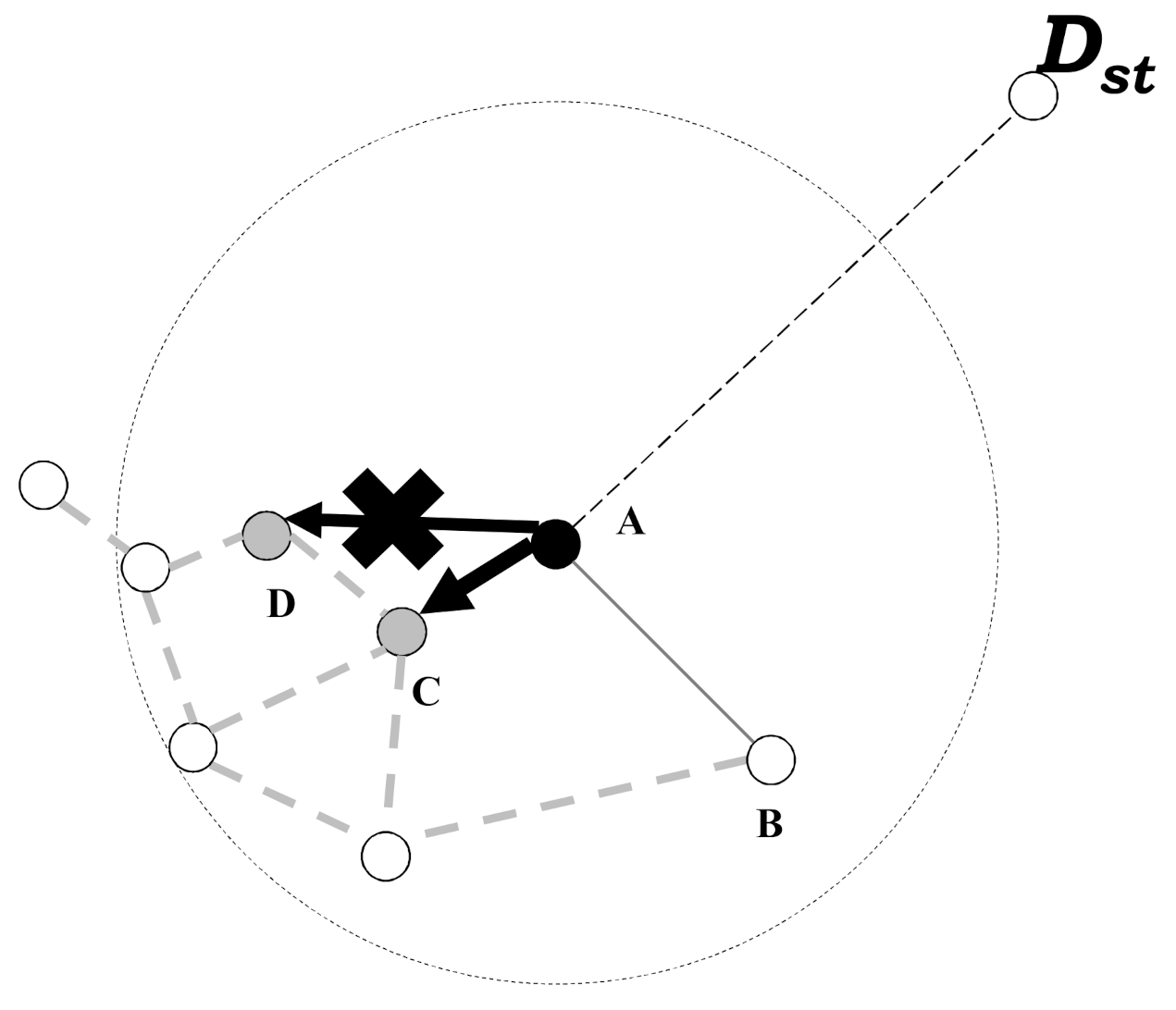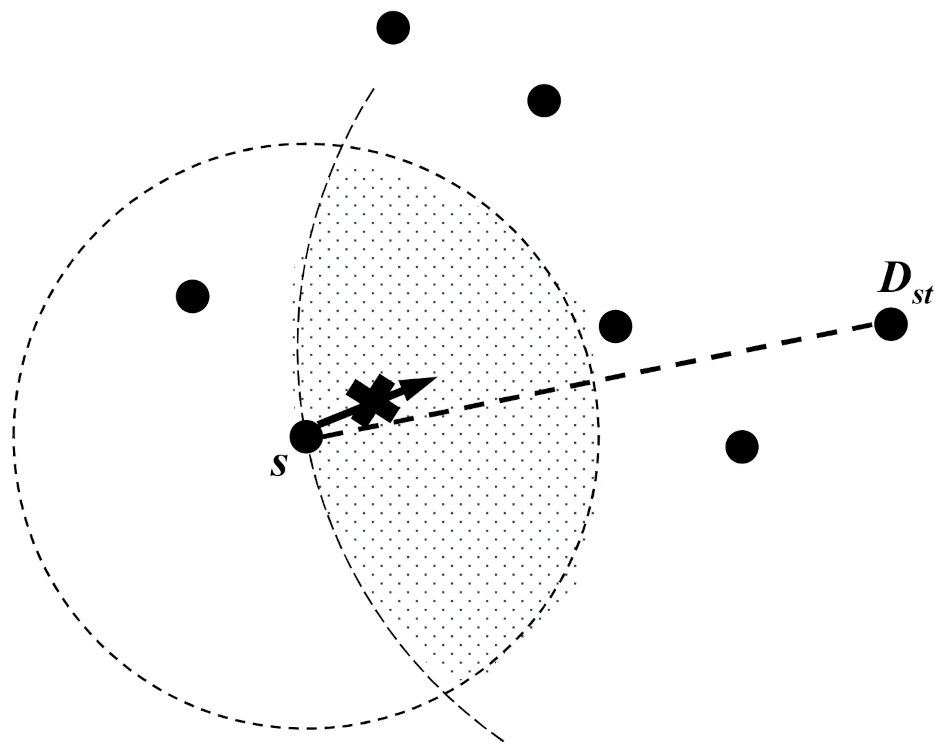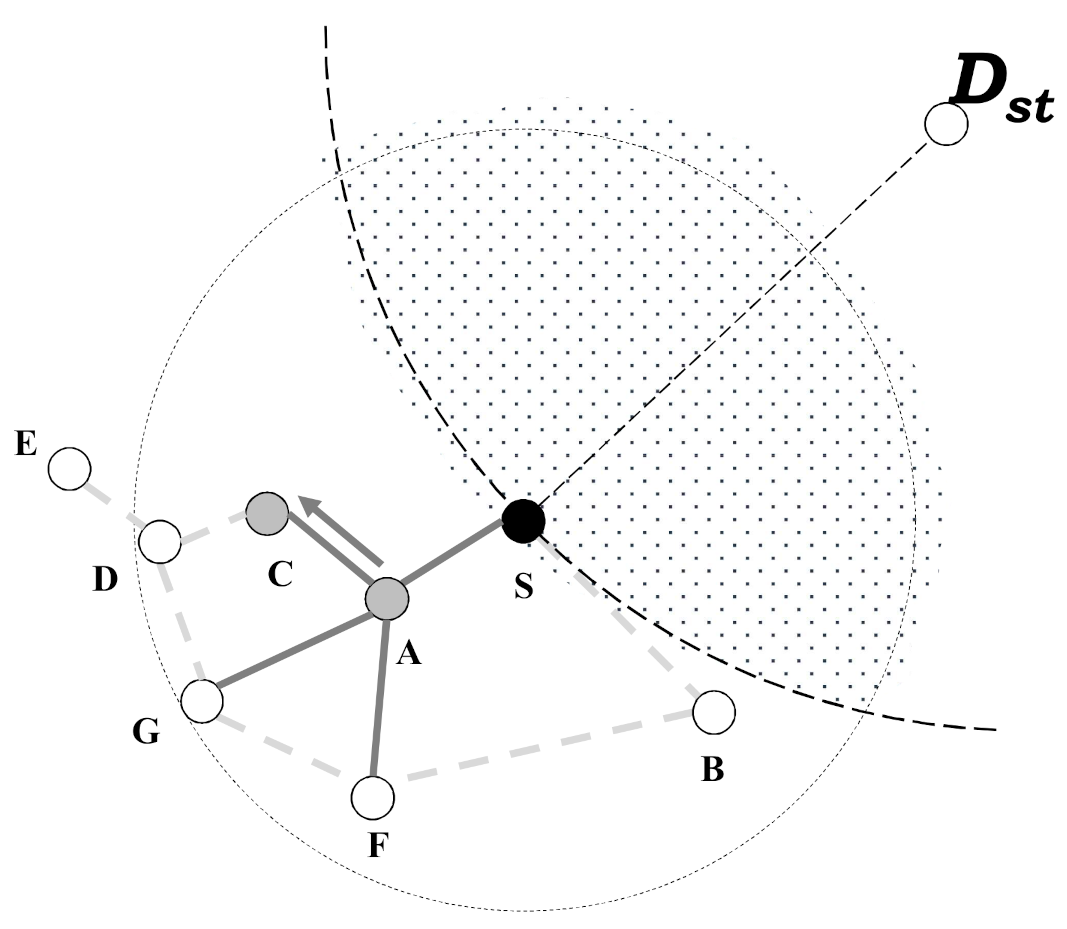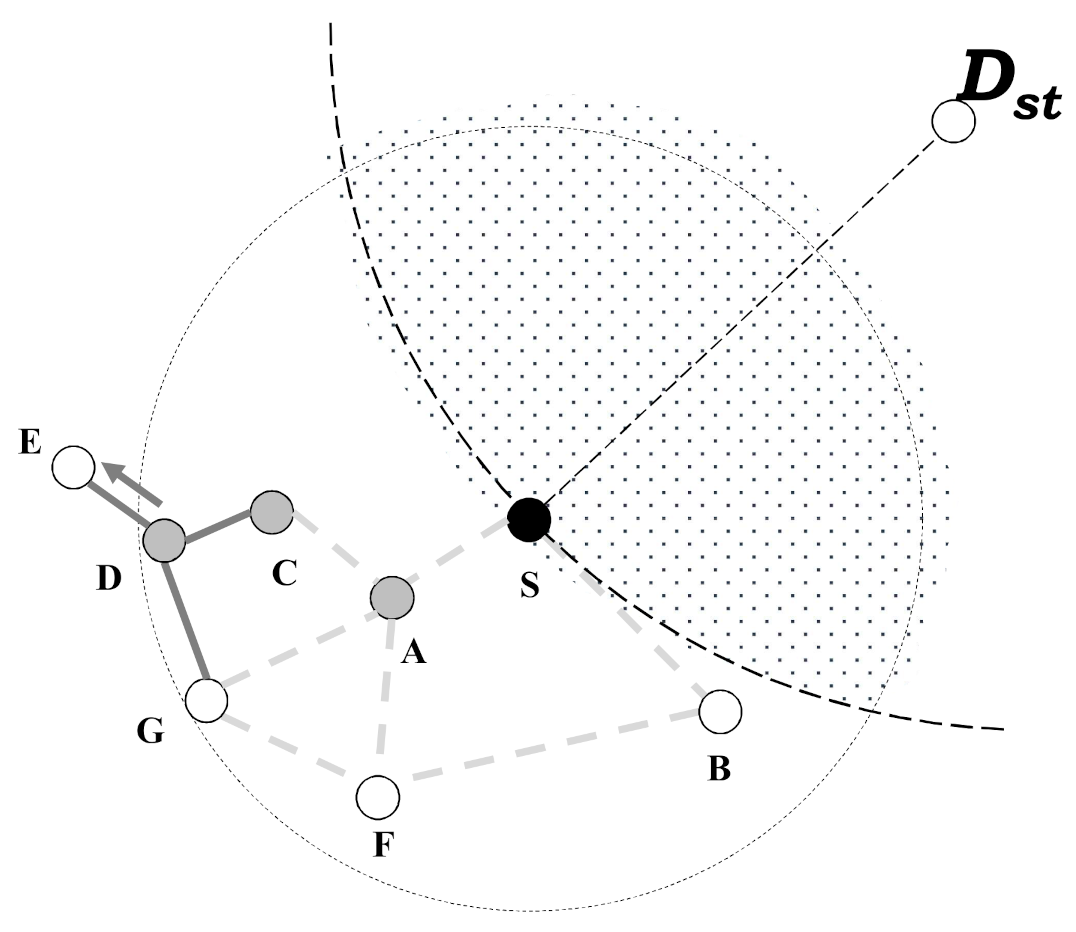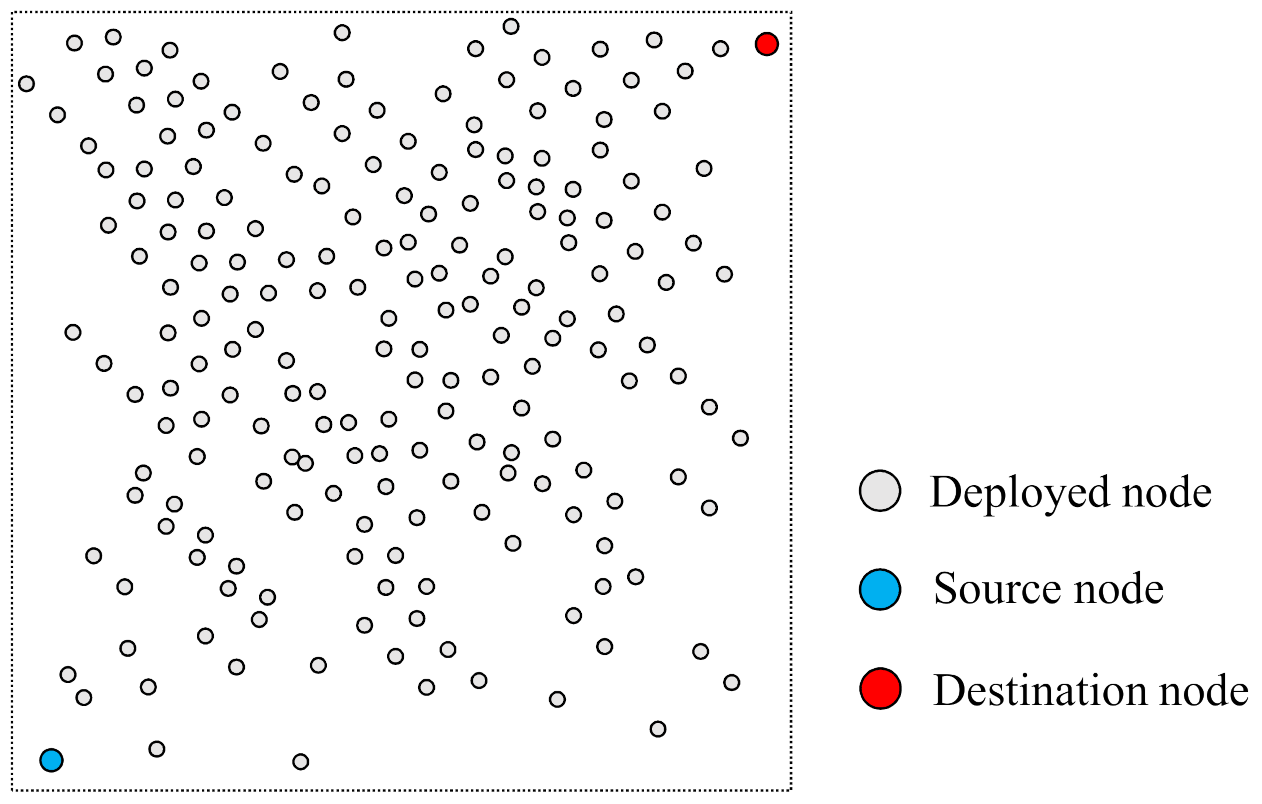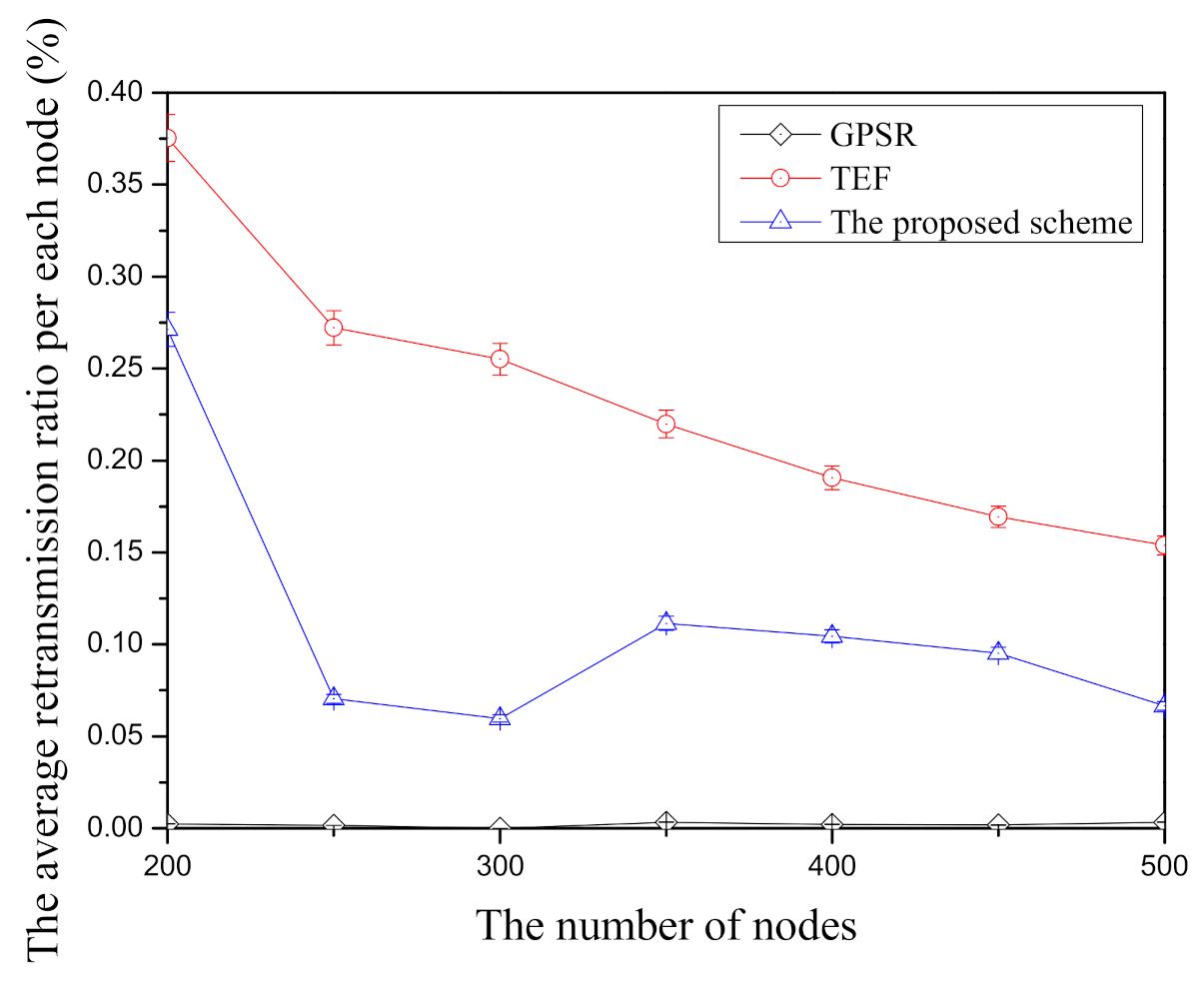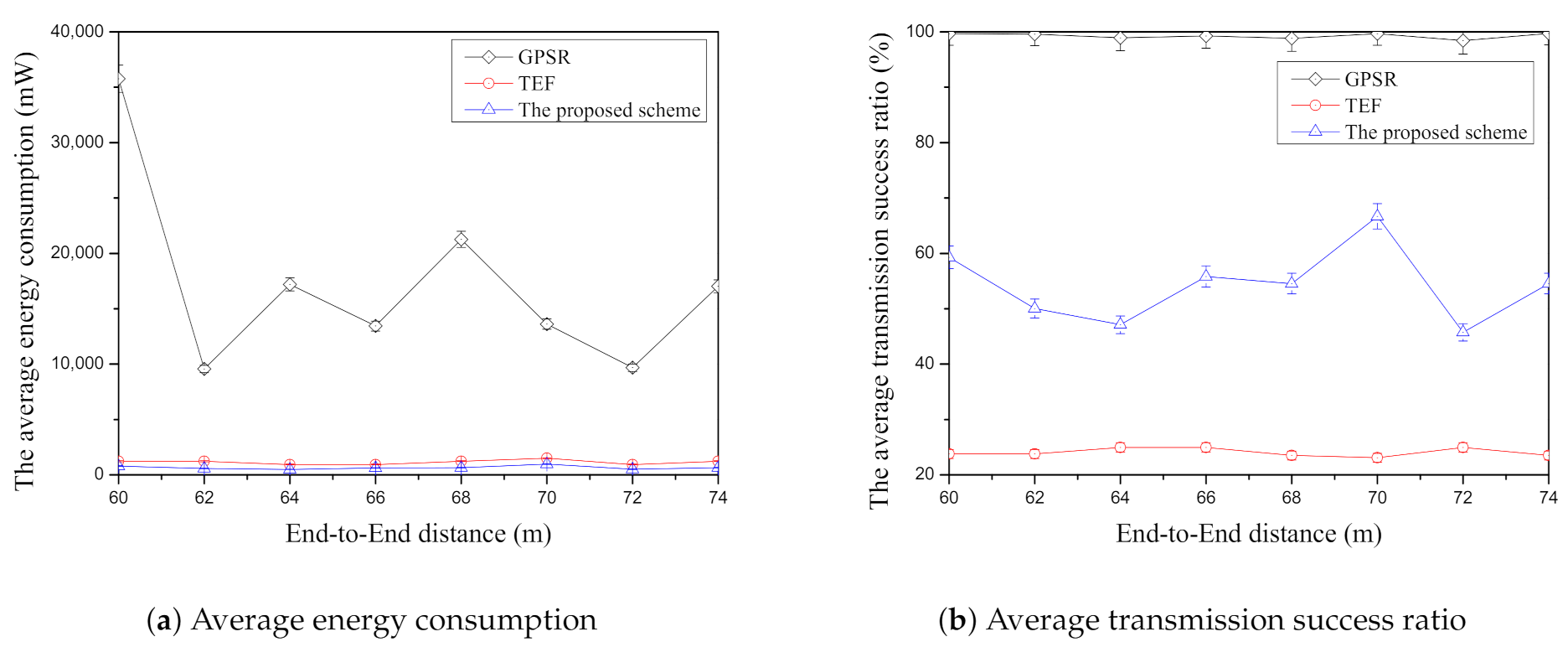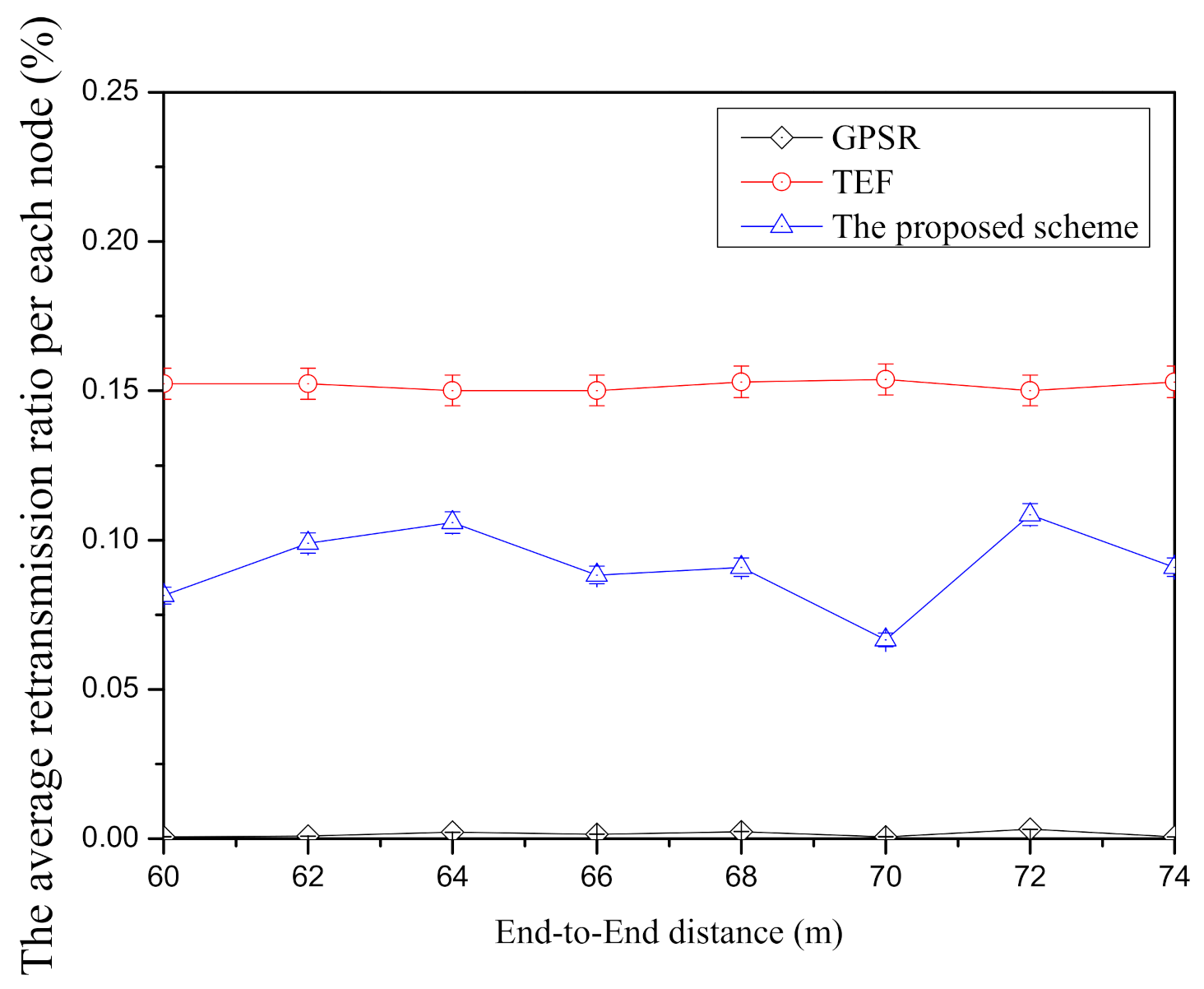4.1. Simulation Environment
This section describes the simulation environment to explain the performance evaluation in detail. This paper exploits the MATLAB simulator [
33] to compare the existing face-routing studies. There are several simulation parameters described in
Table 1 to use in the section. Since this simulation requires only face-routing part in the geographic routing, greedy forwarding of the geographic routing is omitted and only face-routing method is applied to the simulation. Each node initially exchanges its location information to each neighbor node with IEEE 802.15.4 physical and MAC layers.
The nodes were placed in a square area of 80 × 80 m
area and randomly arranged according to the characteristics of the WSN like the
Figure 6. When the simulation performs according to the change in the number of nodes, it performs to change from 200 nodes to 500 nodes. The change in the number of nodes means the node density in the network and then, it is possible to grasp the effect of each face-routing research on the dense environment of the nodes.
In addition, the end-to-end distance, which is the transmission distance from the source node to the destination node, sets to 70 m. When the simulation performs according to the change in the end-to-end distance, it performs to change from 60 m to 74 m. The change according to the end-to-end distance means the change in the overall data transmission distance from the source to the destination node and then, as the distance increases, the number of selected candidate nodes of face-routing increases. Therefore, this simulation can grasp the effect of the increased number of face-routing candidate nodes.
The one-hop radio range of the node sets to 30 m, and when the simulation performs according to the change in the radio range of the node, it performs to change from 30 m to 40 m. The change according to the radio range of the node means an increase in the number of the candidate nodes of face-routing within one-hop range. Accordingly, it is possible to grasp the influence of the increase in the number of candidate nodes of face-routing within one-hop as the radio range increases. This simulation has no significant effect on existing face-routing studies of the nearest-node selection like the GPSR [
6], but it has a great effect on face-routing research of the farther node selection such as TEF [
18] and the proposed scheme.
In this simulation, we compare three studies of face-routing. One is GPSR [
6] and is one of the traditional face-routing techniques in WSN. Also, since GPSR is one of the nearest-node selection methods in face-routing research, it is selected as a simulation comparison target. Another is TEF [
18], which is one of the techniques that improved traditional face-routing research along with GPSR. TEF is one of the farthest-node selection methods in face-routing research. Since this paper is the main target paper to be solved with the proposed scheme, it was selected as a simulation comparison target. The last one is the proposed method, and, therefore, the performance evaluation is conducted with those three simulation targets.
There are three variables used in each simulation: one is the number of nodes, another is end-to-end distance between source node and destination node, and the other is the radio range. The first simulation variable is the number of nodes deployed in the network. As the number of nodes increases, the density of a region increases as well, so that each simulation result value can be compared and analyzed according to this change. The second simulation variable is an end-to-end distance from a source node to a destination node. This distance means a geographic distance between a source node and a destination node calculated by the Euclidean distance formula. As this distance increases, the number of data transmissions increases, so that each simulation result value can be compared and analyzed according to this change. The third simulation variable is a radio range of each node that can transmit data packets. As the radio range of a node increases, the number of searched candidate nodes for face-routing increases, so that each simulation result value can be compared and analyzed according to this change.
There are three results calculated from each simulation: one is the average energy consumption, another is the average transmission success ratio, and the other is the average retransmission ratio for each node. The first simulation result is average energy consumption of the node and this is an average value of total energy consumption of data transmission for each face-routing research. When source and destination nodes are randomly selected and a data packet is transmitted, simulation measures the consumed energy consumption for each node and obtains an average value of this results. Among the communication parts related to energy consumption, some parts may be related to the physical layer or MAC layer. However, since we focus on a part related to a routing part in a network layer, the energy consumption model of the physical layer or MAC layer part was not included in the simulation. Through this process, it is possible to determine which research among the simulation targets consumes more energy and which research consumes less energy. The second simulation result value is average transmission success ratio. This value is an average value of the number of success transmission times measured when simulation transmits data packets from source to destination node. Through this process, the simulation can determine which research has a high transmission success ratio and which research has a low transmission success ratio. The third simulation result value is average retransmission ratio per node. This value is an average value of the retransmission ratio when simulation transmits data packets from source to destination node for each face-routing research. Through this process, when each node transmits data packets in simulation, it is possible to determine which research has a high retransmission ratio and which research has a low retransmission ratio. For the accuracy of simulation, this paper calculates the average results by repeating 200,000 times for each simulation condition on a graph.
4.2. Simulation Results
Figure 7a shows the results of the average energy consumption according to the number of nodes in each face-routing research through the simulation. In
Figure 7a, the GPSR, one of the nearest-node selection schemes of face-routing, is the highest average energy consumption among three face-routing techniques. Since this scheme selects the first adjacent-neighbor node when it searches a candidate node by using face-routing, its candidate node consists of the short distance of the data transmission. For this reason, GPSR usually has the largest number of data transmissions compared with the other two face-routing techniques and it results in the highest average energy consumption. Another face-routing technique is TEF [
18], which is one of the farthest-node-selection techniques of face-routing and which has a lower average energy consumption than GPSR. Unlike GPSR, since TEF can search and transmit the data message to the farthest-neighbor node in one-hop range, it can reduce the amount of data transmission compared with GPSR and have a lower average energy consumption. However, TEF is larger than the proposed scheme since this scheme selects and transmits the farthest-neighbor node in one-hop range. As mentioned above, as the transmission distance increases, the data transmission success ratio decreases [
20,
21,
22]. Since this scheme occurs the data retransmission due to the farthest-node selection, this scheme increases its average energy consumption compared with the proposed scheme. The proposed scheme has the lowest energy consumption compared with the two face-routing techniques. Since this scheme selects an appropriate farther neighbor node by considering its transmission distance and its data transmission success ratio, it can reduce the amount of data transmission and retransmission. Since all face-routing studies have the environment of random node deployment and the random selection of the source and the destination, their results have the fluctuation of the average energy consumption according to the number of nodes. To sum up, GPSR has the largest energy consumption compared with other techniques, TEF is the second largest consumption, and the proposed scheme has the lowest energy consumption in
Figure 7a.
Figure 7b shows the results to present the average transmission success ratio according to the number of nodes among face-routing research. In simulation, the calculated average transmission success ratio is the represented percentage part how much get the success transmission when a candidate node receives from the total number of data message transmissions from the starting node of face-routing. This figure shows that GPSR has the highest average success ratio among three face-routing techniques because of its candidate node selection as mentioned above. Since this scheme selects adjacent candidate nodes based on the planar graph during face-routing, it has a highest average transmission success ratio. On the other hand, TEF has the lowest average transmission success ratio because it searches the farthest candidate node from a starting node of face-routing and transmits the data message to the selected farthest neighbor. As mentioned above, the data transmission success ratio decreases as it transmits the data message to the farther distance in one-hop range [
20,
21,
22]. Therefore, since this scheme retransmit the data message to each candidate node, it has the lowest average transmission success ratio. The proposed scheme is better performance of average transmission success ratio compared with TEF because it selects the candidate nodes with high data transmission success ratio among the farther neighbor nodes in one-hop range. However, compared with GPSR, the proposed scheme is lower average transmission success ratio because it tries to select the farther neighbor nodes to reduce the data transmission. As mentioned above, due to the random node placement and random selection of the source and destination nodes, all the face-routing research has the change of the average data transmission according to the number of nodes but, overall, the average transmission success ratio of GPSR has the highest average transmission success ratio compared with other two schemes. Moreover, TEF is the lowest average transmission success ratio and the proposed scheme is located in the middle.
Figure 8 shows the result of the average retransmission ratio per node according to the number of nodes in face-routing research. In this figure, GPSR has the lowest average retransmission ratio per node among face-routing research because of its node selection scheme. Therefore, since the previous face-routing research selects the adjacent-neighbor nodes based on planar graphs to prevent from a routing problem such as the routing loop state, GPSR usually transmits the adjacent-neighbor nodes that have higher data transmission success ratio when it transmits the data message. Therefore, GPSR has the lowest retransmission ratio per node compared with other face-routing research in the simulation. On the other hand, the TEF has the highest average retransmission ratio per node among face-routing research. It is because TEF searches the farthest-neighbor node in one-hop range and transmits the data message to searched neighbor nodes to reduce the data transmission. However, TEF has the highest data message retransmission ratio due to its node selection scheme. Since the data transmission success ratio gradually decreases as the distance of data transmission is far from one-hop range, this scheme has the highest average retransmission ratio per node. The proposed scheme has the middle position between GPSR and TEF. Unlike TEF, the proposed scheme selects the farther neighbor nodes with the higher average data transmission success ratio and transmits the data messages to the selected neighbor nodes. For this reason, the proposed scheme can reduce the average retransmission ratio per node when it compares with TEF. However, since the proposed scheme selects neighboring nodes that are farther away than GPSR, the retransmission rate is higher than that of GPSR. Like other figures in the simulation, due to the random node deployment and random selection about source and destination, there are lots of changes of the average retransmission ratio per node in all face-routing research according to the number of nodes. Nevertheless, among three face-routing studies, GPSR has the highest average retransmission ratio per node compared with other face-routing techniques, TEF has the lowest average retransmission ratio, and the proposed scheme is in the middle in this
Figure 8.
Figure 9a shows the average energy consumption according to end-to-end distance among face-routing research. In this figure, GPSR has the highest average energy consumption compared with other face-routing research. As mentioned above, since this scheme selects the adjacent-neighbor nodes by using previous face-routing research, their nodes should transmit the data message frequently due to their short transmission distance. It means that GPSR may increase the amount of data transmission when the end-to-end distance increases and it may increase the average energy consumption. TEF has better energy efficiency when it is compared with GPSR. Since TEF transmits the data message to the farthest-neighbor node in one-hop range, it can reduce the amount of data transmission significantly. However, although TEF can reduce the amount of data transmission, it increases the data retransmission ratio because of the farthest-node selection with the lowest transmission success ratio. The proposed scheme is the lowest energy consumption compared with other face-routing research. By selecting the farther candidate nodes with the high transmission success ratio, it can reduce more data transmission than GPSR and reduce more data retransmission ratio than the TEF. As a result, the proposed scheme can decrease the average energy consumption significantly in this simulation. As mentioned above, there are random node placement and the random node selection of the source and the destination and each face-routing research has the various changes of the average energy consumption due to these environments. However, although there are different results of each face-routing research through these changes, among three face-routing techniques, GPSR has the highest average energy consumption, TEF is the second largest energy consumption, and the proposed scheme has the lowest energy consumption as shown in
Figure 9a.
Figure 9b shows the average transmission success ratio according to the end-to-end distance among face-routing research. GPSR has the highest average transmission success ratio in this
Figure 9b because of its node selection method. As described in the previous paragraph, since face-routing is based on the planar graph consisting of the adjacent-neighbor nodes in one-hop range, GPSR has the highest average transmission success ratio among face-routing research. TEF has the lowest average transmission success ratio in
Figure 9b because this scheme searches the farthest-neighbor nodes in one-hop range and transmits the data message to them. As mentioned above, since the data transmission success ratio decreases as the transmission distance increases, TEF frequently retransmits the data message to the searched candidate nodes of face-routing. In simulation, the proposed scheme has the better average transmission success ratio when it is compared with TEF. Unlike GPSR and TEF, the proposed scheme considers two conditions; one is the distance and the other is the data transmission success ratio. Since the proposed scheme selects the farther neighbor with the high data transmission success ratio, it is better average transmission success ratio than the TEF. However, since the proposed scheme tries to select the farther neighbor nodes in one-hop range, it has a lower average transmission success ratio than GPSR as shown in
Figure 9b. As mentioned previous figures in simulation, although there are random node placement and the random selection of the source and destination node, GPSR is highest average transmission success ratio, TEF is the lowest average transmission success ratio, and the proposed scheme is located in the middle between GPSR and TEF.
Figure 10 shows the average retransmission ratio per node according to end-to-end distance in each face-routing technique. In GPSR, it is the lowest average retransmission ratio per node compared with other face-routing research since this scheme transmits the adjacent-neighbor nodes in planar graph. By using the planar graph, GPSR can avoid a routing problem such as the routing loop state and it can increase the data transmission success ratio because its transmission distance between the candidate nodes is short. On the other hand, TEF has the highest average retransmission ratio among three face-routing techniques since this scheme selects the farthest candidate nodes in one-hop range unlike GPSR. As mentioned above, when the transmission distance is far from the starting node of face-routing, it gradually decreases the transmission success ratio and, therefore, this scheme has a lot of retransmission ratio due to its node selection. Compared with TEF, the proposed scheme is lower average retransmission ratio per node because it tries to select the candidate nodes with the high data transmission success ratio to reduce the retransmission between the candidate nodes. However, since the proposed scheme selects the farther neighbor nodes to reduce the amount of data transmission from source to destination node, it has a higher average retransmission ratio per node compared with the GPSR. Although
Figure 10 has the several changes such as the random node deployment and the random node selection of the source and the destination, this figure shows that the GPSR has the lowest average retransmission ratio among three techniques of face-routing, TEF has the highest average retransmission ratio, and the proposed scheme is located in the middle between two face-routing techniques.
Figure 11a shows the average energy consumption according to the radio range compared with face-routing research. Like
Figure 11a, GPSR has the highest average energy consumption compared with two comparisons because this scheme is based on the planar graph when it finds the candidate nodes of face-routing. As mentioned above, the planar graph consists of the nodes that are close to each other and, therefore, this scheme usually transmits the data message to the short distance between the candidate nodes. For this reason, this scheme has a lot of data transmission due to its candidate node selection when it is compared with other face-routing research. In addition, GPSR has the highest average energy consumption regardless of the change of the radio range because the planar graph usually consists of the closest nodes in one-hop range. On the other hand, TEF can reduce the average energy consumption significantly compared with GPSR because it selects to transmit the farthest-neighbor node in one-hop range. Moreover, when the radio range increases in the simulation, TEF can reduce more average energy consumption than the GPSR because it can reduce the amount of transmission by transmitting the data message to the farthest-neighbor nodes in one-hop range. However, TEF increases the data retransmission because it usually transmits the data message to the farthest-neighbor nodes with lowest data transmission success ratio. Unlike other face-routing research, the proposed scheme can reduce the average energy consumption by selecting the farther neighbor nodes in one-hop range and it can also reduce the average energy consumption by selecting the final candidate node of the high average data transmission success ratio among them. In addition, the proposed scheme decreases the average energy consumption according to the increase of the radio range described by
Figure 11a because this scheme can select more suitable neighbor nodes of face-routing in one-hop range when the radio range increases. To sum up, among face-routing research, GPSR has the highest average energy consumption, TEF has the second largest average energy consumption, and the proposed scheme has the lowest average energy consumption in simulation.
Figure 11b shows the average transmission success ratio according to the radio range in each face-routing scheme. As shown in
Figure 11b, GPSR has the highest average transmission success ratio among three face-routing techniques because of the planar graph. This scheme should follow the planar graph that consists of the adjacent-neighbor nodes in one-hop range and determine the candidate nodes of face-routing with this generated graph. As mentioned above, since this scheme transmits the data message to the candidate nodes that are close to each other, it can maintain the higher average transmission success ratio. For this reason, GPSR has the better data transmission success ratio compared with other face-routing research as shown in corresponding simulation results in
Figure 11b. On the other hand, the TEF has the lowest average transmission success ratio because it usually transmits the data message to the farthest candidate nodes with the low data transmission success ratio in one-hop range. Since this scheme searches the farthest-neighbor nodes in one-hop range, it frequently retransmits the data message to the selected candidate nodes because its data transmission success ratio decreases according to the farther transmission distance. The proposed scheme has the better average transmission success ratio than TEF in
Figure 11b. Since the proposed scheme selects the candidate nodes that have the farther distance with the high average transmission success ratio in one-hop range, it can reduce the amount of data retransmission of face-routing. Therefore, the proposed scheme can increase the higher average transmission success ratio than the TEF. However, similar to the recent research such as TEF, since the proposed scheme selects the farther neighbor nodes in one-hop range, its average transmission success ratio is lower than GPSR. Therefore, as shown in
Figure 11b, among three face-routing techniques, GPSR has the highest average transmission success ratio, TEF has the lowest average transmission success ratio, and the proposed scheme is located in the middle position between GPSR and TEF.
Figure 12 shows the average retransmission ratio per node according to the radio range in face-routing research. In GPSR, it has the lowest average retransmission ratio per node among three face-routing technique because of its candidate node selection based on the planar graph. Since face-routing is based on the planar graph when it transmits the data message, GPSR usually selects the closest neighbor nodes with the starting node of face-routing and it has a small retransmission ratio per node. Unlike GPSR, TEF has the highest average retransmission ratio per node among three face-routing techniques because it usually selects the farthest candidate nodes with the low data transmission success ratio due to the farthest transmission distance. The proposed scheme has the better average retransmission ratio per node compared with TEF. Since the proposed scheme selects the farther candidate nodes with the higher data transmission success ratio among them, it can reduce the data retransmission to the candidate nodes of face-routing. However, as shown in this
Figure 12, since the proposed scheme tries to transmit the data message to the farther neighbor nodes in one-hop range, this scheme has a higher average retransmission ratio per node when it is compared with GPSR. To sum up, GPSR has the lowest average retransmission ratio per node compared with two face-routing techniques, TEF has the highest average retransmission ratio per node, and the proposed scheme is located in the middle position between two related face-routing techniques.

